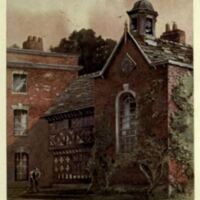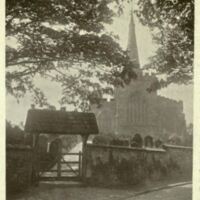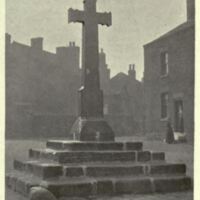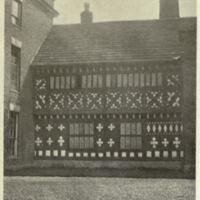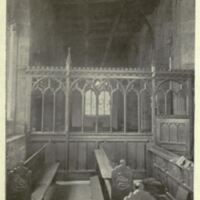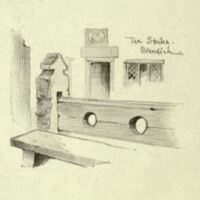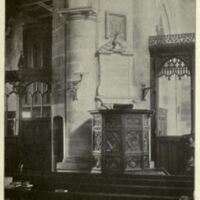Subject
Mackennel continues on from Duxbury to the village of Standish in Lancashire. Standish was the ancestral home of the Standish family along with the nearby Standish Hall. The last surviving section of the house was demolished the 1980s and was already in a state of disrepair during Mackennel’s visit: “Everything has gone to decay”. The house is given a full page colour watercolour by Whymper where the decay is evident. Demonstrating his knowledge of British Mayflower history writing Mackennel notes the changes since William Henry Bartlett’s visit in the 1850s. Most notably the village stocks had been repaired to commemorate Queen Victoria’s diamond jubilee – which are also illustrated by Whymper.
“After a short stay I drove off, back for Standish Church and Hall, along the drive and to the right on the Wigan road; and then the sentiment came, startlingly, quite unlike anything that could have been anticipated. We had reached the Ellerbeck Colliery, when I turned to get a last look at the park. It was no longer visible; a huge tip, stretching from the works to the road, filled up the view. In the hazy light it was a fine object, like a massive bastion, striding out, with a menacing aspect, as if to guard the mansion beyond. So has England changed; castles and military works are gone; homes are defended by productions, the fruit of enterprise and toil.
Turning up a road leading westward, two or three miles before reaching Wigan, I came to Standish Church and village, on the way to Standish Hall. The church is a fine edifice, in excellent preservation, uniformly built in Perpendicular Gothic, of the early Tudor period. Entering by the south porch, you come at once on the Standish chapel, which the later Catholic lords of the manor have not used, although they were the proprietors of the advowson. Directly opposite this is another chapel, serving as a vestry, with Standish graves underneath. There are no conspicuous Standish monuments; but on the northern wall, near the chancel, there is a slab to the memory of a humble Standish, who was gamekeeper to another Lancashire family.
The church floor is largely made up of tombstones; but the nave is so closely filled with pews that no inscription can be read. In the broad market-place outside the church there is an ancient cross, and close by it the stocks, both bearing signs of recent restoration. The stocks have not been used for well-nigh a century; and some time since 1853, when Mr. Bartlett was here, they were removed in a state of partial decay. When, in 1897, there was a question of celebrating the sixtieth year of the Queen's reign by some permanent memorial, on the motion of a primitive village antiquary the stocks were repaired and put back in their original place, and the cross was also cleaned and repaired.
The Standish cottages are not attractive. They are inhabited mostly by colliers, whose families seem abundantly fed, but with little education. A short drive took me to Standish Hall, another building facing the south, standing among fields and within woods, all sadly neglected and suffering from uncontrolled damp; the house has a beautiful prospect, down a wooded valley toward the western side of Wigan. It is not a stately mansion, like Duxbury; it has been built at various times, and can scarcely be called beautiful, but it is eminently picturesque and interesting. The front occupies two sides of an irregular quadrangle. The oldest part is what remains of a two-storied timber house, which was new when Myles Standish was born; on the east side is a chapel, with bell-tower, of red brick and Georgian architecture. At the western end of the timbered building is the doorway, with rooms overhead, and beyond this another Georgian bit of red brickwork, all of plain style and three stories in height. The house ends in a western wing, of a single story, in plastered work and quite modern in date. It looks as if it had been added for a billiard-room; it really consists of two apartments and a corridor. Everything has gone to decay; through the windows, you catch sight of antiquities which you long to examine.
One small room in the original home has a Standish device over the chimneypiece; not the three dishes, but the owl and rat. The north side that is, the back of the hall is really the most picturesque part. On the left is the chapel, with the gable of the nave rising above the lower gable of the chancel. The body of the hall, behind the south front, has three projecting gables over the servants' quarters. Still farther forward are outhouses, with an outer staircase, a laundry with ventilating turret, and beyond this, to the west, another gable. The gables are admirably proportioned, and, rising in their clear colour and fairly sharp edges, they carry on the eye from portion to portion of the home, and set you wondering as to the histories of the rooms they veil.
In this old hall was concocted the Lancashire plot of 1694, for replacing the Stuarts on the throne. Here, doubtless, many a futile dream was dreamed, of changing the new order in Church and State, till gradually the Standishes ceased to find themselves influential persons in the territory of their fathers. Then the hall was let to strangers; for many years France was the loved resort of the owner. Now the ancient mansion is alienated from the race.
Outside the Standish grounds is another colliery, the Prospect pits; and here, too, the mound of refuse has taken the form of a bastion, but not so gloomy nor so grand as that of Duxbury. A visit to the home of the Standishes will give the reflective visitor much material for thought; years roll by in an hour, changes accomplish themselves in his vision, and always there is a human background; it is an old dwelling-place, of men and women and their children, amid whose relics he is standing. But one thing refuses to come when he bids it. There is here no image of Myles Standish. One little object in the Pilgrim Hall, at Plymouth, Massachusetts, awakens a feeling he has not here: a girl's sampler, with the legend, 'Lora Standish is my name.' The name Lora goes back to 1398, when Lora, daughter of Sir Roger de Pilkington, married Lawrence de Standish, of Standish Hall. The memory and fame of the Standishes have passed over with Myles to America.”

